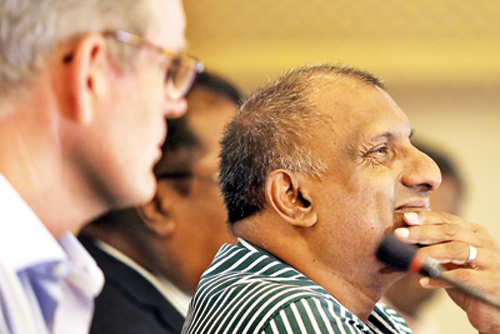Restructuring domestic cricket Moody’s priority
When Sri Lanka roped in Graham Ford for his second tenure as head coach in 2016, it was expected he would turn things around with the wave of a wand. Even bigger hopes were placed on Chandika Hathurusingha who became head coach for a hefty package in return for the pledge of spurring the national team to excellence.

Aravinda de SIlva in a pensive mood next to Tom Moody - Pic by M.A. Pushpakumara
But neither Ford nor Hathurusingha lived up to the expectation of fairytale highs and were sacked before contract expiry. There were others like Simon Willis and Asanka Gurusinha who held key positions within the cricket establishment. The anticipated results never came.
The Board has now turned to Tom Moody, a former Australian international player turned highly-rated coach and mentor. His task is to revamp the cricketing landscape, creating an environment for players to “thrive” in rather than “survive” in.
Moody comes with an impressive CV and a variety of experience from over the world. He served in the Caribbean Premier League, was Worcestershire’s Director Coaching, was with Western Australian cricket, the Pakistan Premier League and Indian Premier League. A significant advantage is prior experience with Sri Lankan cricket in 2005-2007, as head coach, helping the team reach the 2007 World Cup final.
This week, at his first press conference since taking over, Moody was forthright. He sees the need for a competitive cricketing structure that prepares players for the international stage.
“One thing that becomes very clear from having done a lot of research and having had a lot of discussions with people who understand the first-class and domestic game here, is that it’s not a system that supports excellence,” Moody said at a press conference in Colombo.
“That’s something that’s very much a priority in regards to our rebuild. Once you provide a system that provides excellence, you allow talent – which this country is not short of – to thrive. Once you have them in place, you will enjoy the rewards of a new first-class structure and the national team will also respond well. There is an enormous gulf between the first-class structure and what’s on offer in the international stage when you have 26 teams competing.”
Moody believes the absence of a proper and competitive first class structure was the reason why Sri Lanka has struggled to come out swiftly from a transition phase.
“My observation from afar on Sri Lankan cricket is that, like any other country when a side loses some of the game’s greatest players in a short window, it’s very hard to recover from,” he reflected.
“Australia had a very similar situation and they struggled to recover.”
“When you take the heart out of a side–and it happens–it’s hard to recover when you lose players like Murali, Sangakkara, Jayawardene, even if you have planned for the transition, because it is a big gulf to fill,” he continued.
“There is always going to be a recovery period and every nation goes through that. It depends on how swiftly you act to get through that period.”
Sri Lanka’s diluted first-class structure was at the heart of major discussions for many years with former and present cricketers calling for a complete revamp to improve the standard of the game.
However, despite many calling for a reduction in the number of clubs, it’s unlikely they will tamper with that system given the the impact it has had on the game over the years.
“A lot of people are screaming about reducing the number of clubs,” said Aravinda de Silva, the Head of the Cricket Committee.
“But you need to understand it’s the only infrastructure we have had and that we have at the moment. We can’t just kill it overnight and take away the opportunities we provide for those cricketers coming from the school system.”
He had played for NCC from the age of 15.
“We are in the process of reviewing the existing system and, like Tom said, diluting the system doesn’t allow cricketers to play club cricket and then go and play international cricket,” he maintained.
“We need to have a couple of levels above the club structure so that they can get that exposure before graduating to international cricket. We are looking at a pathway all the way from school cricket to international cricket and this will not only produce cricketers but the coaches, officials, curators, match referees and umpires. If we can do that, everything else will be very, very easy.”
Among Moody’s responsibilities is to develop local coaches.
“One of Tom’s main responsibilities is to develop and bring coaches, physios and officials to a level that we need not recruit anyone from overseas to serve in these capacities,” said de Silva.
“After three years [the end of Moody’s tenure] we must develop in Sri Lanka people to hold these positions as coach, physio etc. We are trying to recruit a person for administrative cricket who will be under Moody, to learn from him to carry out this task. There will be education programmes for coaches and development programmes to increase their knowledge.”
It is surprising that Sri Lanka Cricket has been much receptive towards the changes the Cricket Committee is proposing this time around. If all goes well, when Moody leaves on February 28, 2024, Sri Lanka will be better equipped to face the future.



